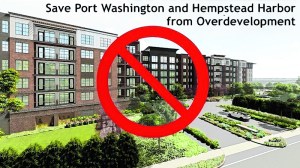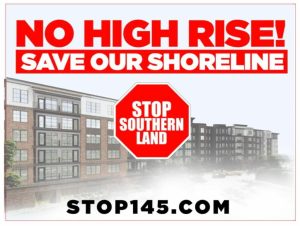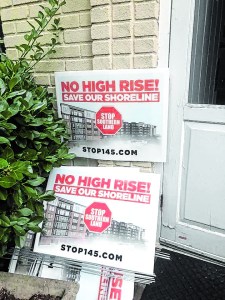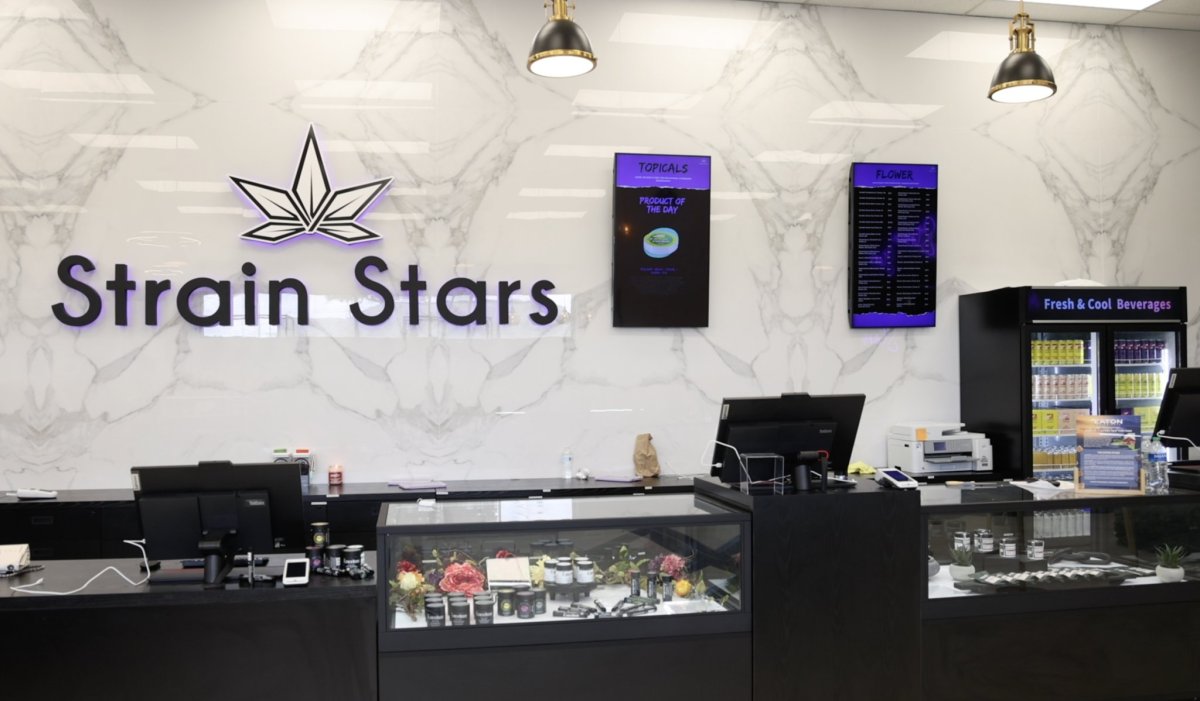Residents are coming together to oppose a proposed luxury apartment building on West Shore Road
Port Washington residents have been working hard to bring awareness to Southern Land Company’s (SLC) proposal for a luxury apartment building on Shore Road. The parcel of land Southern Land Company has scouted out is located at 145 West Shore Rd., next to North Hempstead Beach Park, more commonly known as Bar Beach.
Southern Land Company is asking for the parcel of land to be changed from a Residence AAA zoning (Single-family residencies) to a Multiple Residence zoning. The proposed multi-resident building would be a 96-foot tall, seven-story building with 176 apartments on a two-acre parcel.

The construction of the building would not only be a massive eyesore to Port residents and all who frequent Bar Beach, but the building poses multiple threats to the environment and economy. The developer’s plan for West Shore Road violates six zoning codes, jeopardizes natural assets and encourages dense urban development, according to critics.
Zoning code violations include parking and intrusion on park land, population density violation, height violation, and depth side, back and front violation.
Residents Steven Catrone, Hilary Himpler and Edda Ramsdell have been working to compile research, statistics and relevant information to provide elected officials and Port residents with reasons to stop Southern Land Company from pursuing Port Washington.
“Our key argument is we don’t want a change of zoning at all,” said Himpler. “As soon as we grant this, we will get a whole string of apartment buildings on the shoreline. So we are trying to avoid that before it even begins.”
In this situation, New York’s State Environmental Quality Review Act (SEQR) has to be considered. According to the NYS Department of Environmental Conservation (DEC) website, SEQR “requires all state and local government agencies to consider environmental impacts equally with social and economic factors during discretionary decision making.” This process has to be used when more than one development is being constructed on a property or when designated parkland will be used for development.
In January of 2021, the Town of North Hempstead identified the type 1 considerations from the SEQR that need to be considered concerning the proposed Southern Land Company plan. Those considerations are as follows:
• Surface Water
• Groundwater
• Flooding
• Aesthetic Resources
• Transportation
• Noise, odor, and light
• Human health
• Community Plans and Character
• Financing and accountability.
The residents working to keep SLC out of Port Washington have spent their weekends and free time researching and collecting data regarding the type 1 considerations from the SEQR process.
Flooding Concerns
 Catrone pointed out that if the apartment building were to be built, it would be among the tallest buildings in the town of North Hempstead. While Southern Land Company says that two of the seven stories would be underground for parking, that still leaves five stories above ground and the dangers of underground parking in a DEC wave action zone.
Catrone pointed out that if the apartment building were to be built, it would be among the tallest buildings in the town of North Hempstead. While Southern Land Company says that two of the seven stories would be underground for parking, that still leaves five stories above ground and the dangers of underground parking in a DEC wave action zone.
The parcel of land proposed for SLC’s new development is in a designated area along the coast at high risk for flooding due to storms or seismic sources. Structures built in such locations have Federal Emergency Management Agency (FEMA) regulations and recommendations to consider when building.
FEMA’s regulations set forth procedures and responsibilities, including avoiding floodplain development and new construction in wetlands. Structures built in wetlands would require evacuation for everyone, including their cars, if a severe storm hits.
“What [FEMA] advises is that area should have very well attended wetlands, not buildings,” Himpler said.
The parcel of land has already experienced flooding from severe storms, and the chance of erosion and flooding will just increase with higher tides due to climate change.
Aesthetic Appeal and Community Character
While aesthetics may not seem to be a significant concern to some people, it is a top consideration for the project’s opponents. Bar Beach is a beloved location for not only Port residents but North Hempstead residents, and being right next to a massive apartment building is not part of the view residents expect to see when visiting the beach.
When speaking with Catrone, Himpler and Ramsdell, all three residents expressed their love for Bar Beach. Ramsdell brings her grandchildren there to swim and play, and Catrone frequents the beach often during the hot weather.
“Building this seven-story monstrosity with 176 apartments on only 2 acres of land is like trying to fit 20 pounds of baloney in a 10-pound bag,” Catrone joked.
“[SLC] is talking about installing a speed boat marina,” Ramsdell said. “I can’t imagine having speed boats going back and forth right there when you are trying to swim.”
North Hempstead Beach Park is currently undergoing a massive renovation which received $1 million in federal funding. Months of meetings and visioning went into planning the Bar Beach renovation.
“All of the taxpayers in the Town of North Hempstead have put a lot of money into the whole process of the Bar Beach renovation,” said Himpler.
The master plan of what Bar Beach should look like has been completed for some time now, and a large apartment building that would use parkland for parking was not considered.
The town and community put in time and effort to plan the beach renovation and create a place that would include charm and generous amenities. Cementing over parts of the beach disrupts the vision for the renovation that so many are looking forward to.
Noise, Odor and Light
The parcel of land on West Shore Road is on the coast and across from 200 acres of the Hempstead Harbor Woods and Moutain Bike Trails. Critics say that 176 apartments filled with families jeopardize the safety of the nature preserve and aquatic life offshore.
The Harbor Management Plan for Hempstead Harbor was prepared for the Hempstead Harbor Protection Committee with support from Nassau County, North Hempstead, the Village of Sands Point, and other neighboring villages and towns.
According to the Harbor Management Plan, their goals include increasing water-related recreational opportunities within and along the shoreline and protecting the harbor’s natural environment, surface water quality, wetlands, coastal fish and wildlife habitats.
“There are 220-something species of bird in [the Hempstead Harbor Woods] in addition to fox, deer and bunnies,” said Himpler.
The Town of North Hempstead Planning Office provided a supplement to the full environmental assessment form that details aspects of the SEQR type 1 considerations. The impacts on noise, light and odor expect environmental remediation and subsequent construction period to last from 18 to 24 months. Common construction impacts listed include traffic detours, transport and use of heavy equipment, temporary work lighting and stormwater diversion for an extended duration.
The commotion and pollution that comes with the months of construction and the following emissions from added cars from the hundreds of people living in the apartments will affect the wildlife in the woods and water surrounding the area. Protecting the harbor’s viability and water quality is a priority that concerned residents are looking at when considering the SLC development.

(Photo from Edda Ramsdell)
Overpopulation and Traffic
According to the 2010 census, Port Washington’s population density averaged 3,575 people per square mile. In the 2020 census, Port Washington’s population density grew to an average of 5,373 people per square mile. These calculations include Baxter Estates Village, Port Washington CDP, Port Washington Village North, Manorhaven, Flower Hill, and Sands Point.
In Nassau County, the population density per square mile in 2020 is 4,902, significantly less than Port Washington.
“We thought this was really telling,” said Himpler when presenting the data. “If you look at Nassau County, the population density for the whole county is less than what they’re trying to stick in Port Washington, and they haven’t even built this building yet.”
Himpler pointed out that between 2010 and 2020, Port Washington experienced substantial population growth due to development in Manorhaven and on the coast of Manhasset Bay. But with the addition of SLC’s apartments, the population would only grow, which stresses human health, small businesses and infrastructure.
“Local businesses generally think the more people living here, the more business they will get,” said Himpler. “But if there is no parking, people aren’t going to go.”
“With boarded-up stores on Main Street, people think this apartment building will help, but shopping locally is what truly helps,” said Catrone.
An increase in population means an increase in traffic, which is already an issue in Port Washington.
“This town is bursting at the seams with traffic, especially on Beacon Hill Road to Main Street,” said Catrone.
“We had a traffic study done in 1995 on Beacon Hill Road because of the traffic problems then,” said Ramsdell. “It was found 10,000 cars travel there per day. Now with the traffic study done more recently, it estimates 1,200 cars an hour.”
According to the supplement to the full environmental assessment form provided by the Town of North Hempstead Planning Office: “Weekday traffic volumes on West Shore Road averaged 1,222 vehicles during the morning peak hour and 1,322 vehicles during the evening peak in the vicinity of the subject property. The 176-development is projected by the Project Sponsor to generate an additional 63 and 77 trips, respectively.”
Taxes in the Town of North Hempstead
When large projects come to town, residents often worry about how their taxes will be affected. Catrone, Himpler and Ramsdell have researched the use of Industrial Development Agencies (IDAs) in projects such as SLC’s apartment building.
IDAs are available in most counties and fund projects that increase employment. While there will be a lot of jobs in construction when the project is underway, when it is done, there is only going to be an estimated four to five full-time types of employment at the apartment building, explained Himpler.
“[SLC] would get all this money, funding for their project. But the downside is they don’t have to pay taxes on construction materials,” explained Himpler. “So the county automatically loses revenue right there. The impact will be that taxes for the residents will probably go up.”
Himpler gave an example of IDAs affecting residents in Glen Cove. Garvies Point in Glen Cove has a lot of newer developments, and when they started their first project with RXR Reality, taxes in the city went up for all residents.
“The payments [from using IDAs] start low and rise gradually until you reach the total over 20 years,” said Himpler. “In this past year, [RXR Reality] told the [Glen Cove] board that they are moving the payout time from 20 years to 40 years. It is an abuse of power.”
“The financial impact would affect all of North Hempstead, not just Port Washington,” said Himpler.
Current Property Lease
Barker Aggregates, LTD is currently leasing 145 West Shore Rd. Barker Aggregates handles barge unloading and truck loading that serves Nassau and Suffolk counties. Port Washington is one of their two terminals on Long Island, the other being Port Jefferson.
In March of 2021, the company sent a letter to the Town of North Hempstead regarding the March 2021 scoping session for SLC development. As one of the five transshipment points for the Long Island Sound region, hindering or eliminating their services in Port Washington would have a regional impact on “traffic, air emissions, health and the regional economy,” according to their letter.
Barker Aggregates supplied a chart comparing transportation modes to show how the elimination of their port would affect the transportation of their cargo. One inland barge of dry cargo transport is equivalent to 16 bulk rail cars and 70 tractor trailers. One inland barge of liquid cargo transport barge equals 46 rail cars and 144 tanker trucks.
“The environmental benefits of barging versus carrying the same material by truck on the NYC and Long Island’s roadways are enormous,” wrote Barker Aggregates. “The foreseeable impacts of reducing the capacity to carry water-borne freight needs to be evaluated and addressed in all relevant sections… including traffic, air emissions, fiscal and economic conditions and greenhouse gas emissions.”
Resident Effort
Catrone, Himpler and Ramsdell have been working hard to rally residents to oppose the SLC development. In March of this year, the team wrote a letter to the town of North Hempstead detailing their concerns about the development. The letter is signed by multiple neighborhood associations and civic organizations, including New Salem Civic Association, Port Washington Park Civic Association, Mitchell Farms Neighborhood Association, Montfort Hills Civic Association, Bayview Colony, Eastern Crest Civic Association, Beacon Hill Residents Association, The Harborside, and Transition Town Port Washington.
The signed organizations are also anticipated to be a part of the “Save Our Shorelines” coalition that Catrone, Himpler and Ramsdell are forming to strengthen their fight to protect the Port coast from overdevelopment.
The letter got Catrone, Himpler and Ramsdell a meeting with Town Supervisor Jennifer DeSena, Deputy Supervisor Joe Scalero and District 6 Councilmember Mariann Dalimonte.
“We had issues to sort out, and I think we were there about two hours,” said Himpler about the meeting. “A lot of stuff revolved around traffic concerns.”
While at the time, the residents felt the town officials didn’t know much about the SLC development, they were still very receptive to the concerns laid out. Catrone, Himpler and Ramsdell have faith in their efforts and trust Councilmember Dalimonte to listen to their concerns. Catrone joked that Dalimonte is called for everything in Port Washington, even when a light bulb is out on Main Street, and she will fix it.
“In terms of the meeting, I think it went very well,” said Himpler. “They got the message. The whole subject of the meeting was to stop selling and using marketing ploys when you have been sitting on the land since 1986 and never done anything to help it.”
The letter to the Town of North Hempstead Supervisor and Councilmembers states: “The developers have shrouded their over-the-top sell job with the promise to clean up their environmental waste. This marketing assertion in itself indicts the owner(s) of the site for not maintaining nor remediating their shoreline property since purchasing it in 1986. As it stands now, failure to remediate the original site pollution and then continue to further pollute the site over many years negates their attempt to tout themselves as saviors of Hempstead Harbor. This is nothing more than a marketing/selling ploy to cover the costs of remediation under an IDA while continuing to pollute the area with too many people and their cars.”
As a Port Washington history lover, Catrone explained that at one point, that land was all sand and gravel. That material was used to build skyscrapers in New York City. In addition, in World War I and II, there was a pier for ships to get in and out.
“It’s our heritage and history,” said Catrone.
In addition to researching development effects and speaking to town officials, a petition has been circling Facebook and other social media outlets for residents to sign in protest of the development.
As of Aug. 18, the petition has 4,603 signatures and multiple comments detailing reasons for signing.
Visit stop145.com to sign the petition or participate in a letter-writing campaign that will send an email to the town supervisor and members of the Town of North Hempstead Town Board.
According to an update from Councilmember Dalimonte’s newsletter, at the Sept. 1 Town Board meeting, “ the town board, as the Lead Agency, will accept the DEIS (Draft Environmental Impact Statement) as “complete,” open the public comment period, and set a hearing date for Wednesday, Sept. 28.” To view the DEIS, visit northhempsteadny.gov/planning.



























